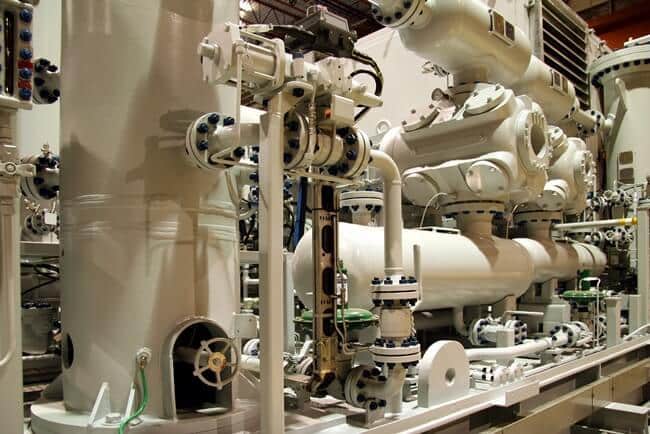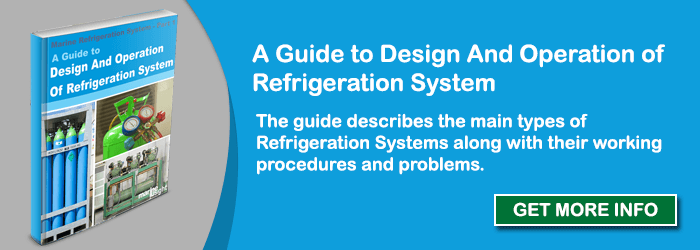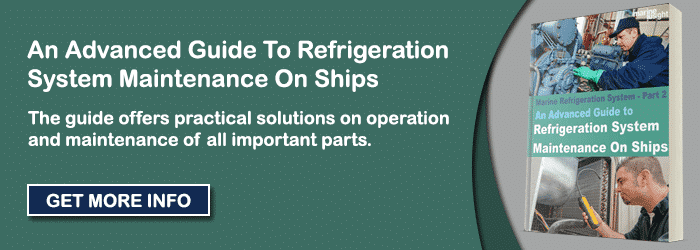Construction and Working of Ship’s Refrigeration plant
The refrigeration plants on merchant vessels play a vital part in carrying refrigerated cargo and provisions for the crew on board. In reefer ships, the temperature of the perishable or temperature sensitive cargo such as food, chemical, or liquefied gas, is controlled by the refrigeration plant of the ship. The same plant or a smaller unit can be used for maintaining the temperature of different provision rooms carrying food stuffs for crew members.
The main purpose of ship’s refrigeration plant is to avoid any damage to the cargo or perishable material so that it is transported in good and healthy condition. Refrigeration prevents growth of micro-organisms, oxidation, fermentation and drying out of cargo etc.

Main Components of Refrigeration plants
Any refrigeration unit works with different components inline to each other in series. The main components are:
1. Compressor: Reciprocating single or two stage compressor is commonly used for compressing and supplying the refrigerant to the system.
2. Condenser: Shell and tube type condenser is used to cool down the refrigerant in the system.
3. Receiver: The cooled refrigerant is supplied to the receiver, which is also used to drain out the refrigerant from the system for maintenance purpose.
4. Drier: The drier connected in the system consists of silica gel to remove any moisture from the refrigerant
5. Solenoids: Different solenoid valves are used to control the flow of refrigerant into the hold or room. Master solenoid is provided in the main line and other solenoid is present in all individual cargo hold or rooms.
6. Expansion valve: An Expansion valve regulates the refrigerants to maintain the correct hold or room temperature.
7. Evaporator unit: The evaporator unit act as a heat exchanger to cool down the hold or room area by transferring heat to the refrigerant.
8. Control unit: The control unit consist of different safety and operating circuits for safe operation of the refer plant.
Working of Ship’s Refrigeration Plant
The compressor acting as a circulation pump for refrigerant has two safety cut-outs- Low pressure (LP) and High Pressure (HP) cut outs. When the pressure on the suction side drops below the set valve, the control unit stops the compressor and when the pressure on the discharge side shoots up, the compressor trips.
LP or low pressure cut out is controlled automatically i.e. when the suction pressure drops, the compressor stops and when the suction pressure rises again, the control system starts the compressor. HP or high pressure cut out is provided with manual re-set.
The hot compressed liquid is passed to a receiver through a condenser to cool it down. The receiver can be used to collect the refrigerant when any major repair work has to be performed.
The master solenoid is fitted after the receiver, which is controlled by the control unit. In case of sudden stoppage of compressor, the master solenoid also closes, avoiding the flooding of evaporator with refrigerant liquid.
The room or hold solenoid and thermostatic valve regulate the flow of the refrigerant in to the room to maintain the temperature of the room. For this, the expansion valve is controlled by a diaphragm movement due to the pressure variation which is operated by the bulb sensor filled with expandable fluid fitted at the evaporator outlet.
The thermostatic expansion valve supplies the correct amount of refrigerants to evaporators where the refrigerants takes up the heat from the room and boils off into vapours resulting in temperature drop for that room.
This is how temperature is maintained in the refrigeration plant of the ship.
You might also like to read –
Guidelines on Quality of Refrigerant Used on Ships
References: Marine Aux Machinery by H.D.McGeorge
Do you have info to share with us ? Suggest a correction

About Author
An ardent sailor and a techie, Anish Wankhede has voyaged on a number of ships as a marine engineer officer. He loves multitasking, networking, and troubleshooting. He is the one behind the unique creativity and aesthetics at Marine Insight.
Subscribe To Our Newsletters
By subscribing, you agree to our Privacy Policy and may receive occasional deal communications; you can unsubscribe anytime.






can someone pls share the procedure to charge oil into ref. compressor. thank u
If you were to walk past a refer plant on board and you saw bubbles in the sight glass, what problem would you suspect to be the problem and how could this be rectified?
If anyone could answer this question I would be very greatful?
Hi jghesari-
It indicates that their is air entrapment inside the line or the line itself is undercharged.
Collect all the refrigerant in the condensor and cool it down for some time. Air being lighter, it will come up and vent the air carefully in an empty bottle.
what are the reasons that will produce high discharge pressure of a refrigeration compressor which will lead to HP cut out.?
because if the compressors stops. the cycle also stops?? please answer…i’ really bothered
Yes! if the compressor stops, the cycle will also stop. first the reason for stopping of the compressor has to be rectified before starting up again.
What are pre-checks before starting Refrigeration System?
can u please explain the difference between function of solenoid valve & thermostatic expansion valve, both sounds like having the same function ?
Greetings Mr.Anish and Mohit team in marine insight,
Your job is really good and appreciated.
When I look into the HVAC side, as I am looking more practical issue on board ship with Infrared thermography and Airborne ultra sound tools, one important topic for practical applications is to be mentioned. about Degree of super heat and Sub cooling. how to measure and what will be the problems if not maintained correctly. How the compressor break downs occurs etc.,
Kind regards
Chary
How thermostatic expansion valve fitted on refrigeration system
@ Amit: I am assuming you want to know the selection procedure of the expansion valve. It will depend on the sepcifications of the refrigeration plant. Following points to be considered-
– Pressure drop accross the valves
– Liquid temperature of the refrigerant entering the valve
– System capacity requirements
etc….
“The hot compressed liquid is passed to a receiver through a condenser to cool it down.”
Hot compressed gas I believe?
The BASICS I seem to recall from school are:
-Compressor compresses the gas – high pressure / high temperature gas
-Condenser cools the high press/high temp gas to high press/cool temp liquid
-Expansion v/v converts high pressure/cool temperature liquid to low pressure/low temperature liquid
-Evaporator then delivers heat to the low temp/low pressure liquid, thus evaporating it to a low pressure/ (~intermediate/higher) temperature gas
Then the compressor compresses the gas again to continue the cycle.
We don’t want liquid trying to be compressed.
@ Anoop: HP Cutout:
Occurs due to condenser coolant failure, low coolant pressure and malfunction of consider cooler valve operation.
Also can cause dirty or chocked condenser tubes.
The refrigerant can not liquefy rapidly .The discharge pressure will abnormally raise and high pressure cut out will take in action.
Sir I have already completed diploma in refrigeration and air conditions in govt college and my near have one years experience in merchant navy on board ship sir I wana working on ship refrigeration plant if have any vacancy plz call me my name is Narender my contact number +919983288836 plz call me sir I wana working ship refrigeration
this is good n all but do you know what temperatures these would run at? both outside and inside the evaporator.
Hi.i want to know the procedure for change over the refrigeration system to use stand by refrigeration system.tanks
Effect of dirty air compressor and high ambient temperature in refrigeration system
TEV cotrols and regulate the flow of refrigerant, so then why solenoid valve is required?
My name is rajesh i am also working in aship based compnyas per the post of HVAc teachnician today i am going to one vessel there Hp is 22 bar, there water coolent pressure ok inlet outlet flow also ok drier core also new compressor valvplate also new any other prblm for there happen?
How the evaporators drain works? The whole line , its fittings and diagram please
How baffle type oil separator of refrigeration cycle works?
@Gopal: The oil and gas mixture slows down rapidly on the surface of the baffles. Very fine oil particles collide with one another and form heavier particles. Finally, fine mesh screens separate the oil and refrigerant even farther, causing larger oil droplets to form and drop to the bottom of the separator. We have a separate video course which shows the working of different refrigeration parts including baffle plates. –
https://learn.marineinsight.com/course/refrigeration-course/
Hello sir, can you please give a link or please explain how dose a defroster work in our refrigeration plant’s
What is the purpose of back pressure valve in refrigeration system
@Shahid: It is fitted at the outlet of the evaporator coming from different rooms at different temperature. Its purpose is to maintain a constant pressure and constant of saturation temperature in the evaporator, regardless of the pressure changes elsewhere in the system.
In provision refer plant, how to transfer refrigerant from condenser of one unit to condenser of other unit?
hello! how do we transfer refrigerant from system #1 to the other reefer system(2),given that the #1 was already pumped down?
Sir good day, what is the starting and stopping procedures in a refrigeration system? Thank you! ?
It is necessary to add filter in the refrigerant ciycle? And why?
It is necessary to add filter in the refrigerant circle? And why?